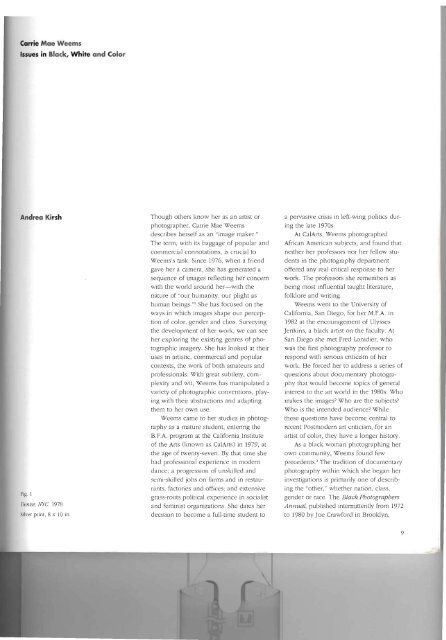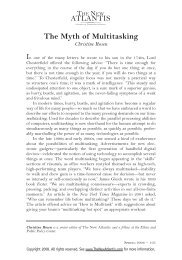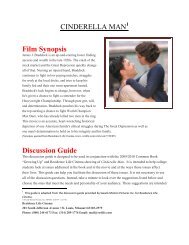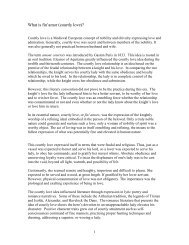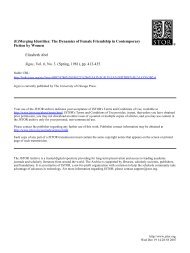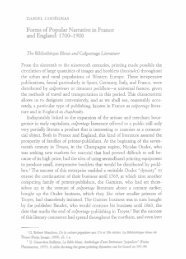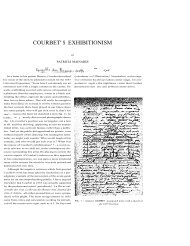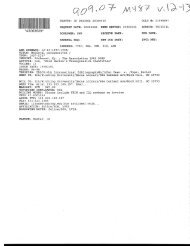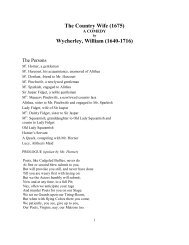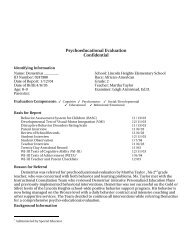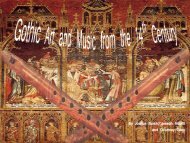CARRIE MAE WEEMS - People Search Directory
CARRIE MAE WEEMS - People Search Directory
CARRIE MAE WEEMS - People Search Directory
Create successful ePaper yourself
Turn your PDF publications into a flip-book with our unique Google optimized e-Paper software.
Carrie Mae Weems<br />
Issues in Black, White and Calor<br />
Andrea Kirsh<br />
Fig. 1<br />
Denise, NYC. 1978<br />
Silver print, 8 x 10 in.<br />
Though others know her as an artist or<br />
photographer, Carrie Mae Weems<br />
describes herself as an "image maker."<br />
The term, with its baggage of popular and<br />
commercial connotations, is crucial to<br />
Weems's task. Since 1976, when a friend<br />
gave her a camera, she has generated a<br />
sequence of images reflecting her concern<br />
with the world around her-with the<br />
nature of "our humanity, our plight as<br />
human beings.'" She has focused on the<br />
ways in which images shape our perception<br />
of color, gender and class. Surveying<br />
the development of her work, we can see<br />
her exploring the existing genres of phorographic<br />
imagery. She has looked at their<br />
uses in artistic, commercial and popular<br />
contexts, the work of both amateurs and<br />
professionals. With great subtlety, complexity<br />
and wit, Weems has manipulated a<br />
variety of photographic conventions, playing<br />
with thei.r abstractions and adapting<br />
them to her own use.<br />
Weems came to her studies in photography<br />
as a mature student, entering the<br />
B.F.A. program at the California Institute<br />
of the Arts (known as CalArts) in 1979, at<br />
the age of twenty-seven. By that time she<br />
had professional experience in modern<br />
dance; a progression of unskilled and<br />
semi-skilled jobs on farms and in restaurants,<br />
factories and offices; and extensive<br />
grass-roots political experience in socialist<br />
and feminist organizations. She dates her<br />
decision to become a full-time student to<br />
a pervasive crisis in left-wing politiCS during<br />
the la te 1970s<br />
At CaJArts, Weems photographed<br />
African American subjects, and found that<br />
neither her professors nor her fellow students<br />
in the photography department<br />
offered any real critical response to her<br />
work. The professors she remembers as<br />
being most influential taught literature,<br />
folklore and writing.<br />
Weems went to the University of<br />
California, San Diego, for her M.F.A. in<br />
1982 at the encouragement of Ulysses<br />
Jenkins, a black artist on the faculty. At<br />
San Diego she met Fred Lonidier, who<br />
was the first photography professor ro<br />
respond with serious criticism of her<br />
work. He forced her to address a series of<br />
questions about documentary photography<br />
that would become ropics of general<br />
interest ro the art world in the 1980s: Who<br />
makes the images? Who are the subjects?<br />
Who is the intended audience? While<br />
these questions have become central to<br />
recent Postmodern art criticism, for an<br />
artist of color, they have a longer history.<br />
As a black woman photographing her<br />
own community, Weems found few<br />
precedents.' The tradition of documentary<br />
photography within which she began her<br />
investigations is primarily one of describing<br />
the "other," whether nation, class,<br />
gender or race The Blacl~ Photographers<br />
Annual, published intermittently from 1972<br />
to 1980 by Joe Crawford in Brooklyn,<br />
9


